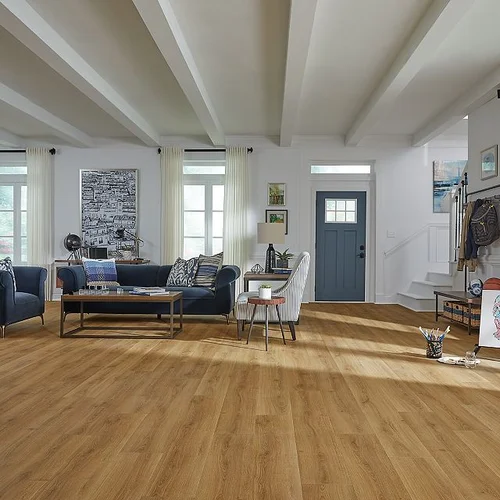Floor Refinishing in Fort Mill
Local Floor Refinishing
The flooring in a home is a major investment, so it makes sense that homeowners will want to learn the best way to protect that investment for as long as possible. Floor refinishing is the easiest and fastest way to prolong the life of a floor, as well as keep the floor shiny, scratch-free, and moisture-resistant. Check out everything you need to know about refinishing floors at Gil Flooring Solutions in Fort Mill, SC.
Floor Refinishing in Fort Mill: Can All Floors Be Refinished?
Choose the best flooring based on your need
Carpet
LVT
Hardwoods
Floor Refinishing by type:
Hardwood Floors
To refinish a hardwood floor, the first thing that must happen is sanding to remove the old protective layer, along with any scratches, dents, or other minor damage. For areas of the floor that have been too worn, it may be necessary to replace planks. After hardwood floors have been sanded, a new stain for the wood can be applied, followed by a protective coating made with water or oil-based polyurethane.
Most genuine hardwood floors can be refinished six to ten times. Since hardwood only needs to be refinished every eight to 12 years, this means that regularly refinishing hardwood flooring will ensure the floor lasts a lifetime. Some homes with low traffic may need to have floors refinished less frequently. The thickness of the hardwood planks will determine how many times a floor can be refinished before it needs to be resurfaced or replaced.
Vinyl Floors
Vinyl floors are designed to provide a high level of shine for an extended period of time. However, to keep vinyl flooring looking as good as new, it may be a good idea to apply a new finish to the floor every six to 12 months. Vinyl floors can withstand light buffing to remove any scratches; however, this task should be done by a professional to avoid damaging the vinyl. The same protective urethane or no-wax seal originally used as the vinyl wear layer will be reapplied after the scratches are removed.
Laminate Floors
Laminate floors are made with compressed wood fibers and a printed image, so homeowners must be careful to avoid damaging the image on the floor. After a professional has buffed away any damage to the laminate floor, a new protective seal will be applied
Tile Floors
Finally, tile floors can also be refinished. Similar to vinyl floors and laminate floors, the process to refinish a tile floor will not usually involve sanding. Instead, to refinish a tile floor, a professional will need to use clear epoxy and glue to correct any cracks or loose pieces. Damaged or old grout will also be removed before new grout can be applied to the tiles. The last step after the grout has dried is applying a new seal layer to protect the floor.
Why Should You Consider Floor Refinishing Instead of Replacing?

Refinishing a floor is significantly cheaper than replacing a floor. Regardless of the flooring type in a home, it’s more affordable to refinish a floor with a new protective seal than rip up the flooring altogether. Refinishing is also much faster than replacing a floor, which means the lives of people dwelling in the home will not be upended while this work is being done.
Furthermore, the fact of the matter is that most floors will not need to be replaced very frequently. Vinyl and laminate floors can look brand-new with regular refinishing for 10 to 20 years, or sometimes more. Tile floors and hardwood floors are also designed to last a lifetime, so it makes no sense to replace the floor entirely when scratches can be easily fixed with a new protective wear layer.
How Do You Know It’s Time to Refinish a Floor?
Regardless of the type of flooring in a home, there are several common signs that indicate it’s time to refinish the floor. Obvious or very large dents, scratches, and stains are one of the biggest reasons homeowners refinish a floor. A homeowner may also choose to refinish a floor to correct water damage, fading, dullness, and discoloration.
Floor refinishing is one of the regular duties homeowners must perform to keep floors in good shape. From hardwood to laminate to tile, refinishing a floor by applying a new seal can ensure the flooring is protected.
Looking for a local and professional floor refinisher in Fort Mill? Give Gil Flooring Solution a call at (704) 245-9110 and we will discuss what flooring options may be right for you!
